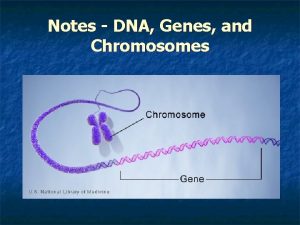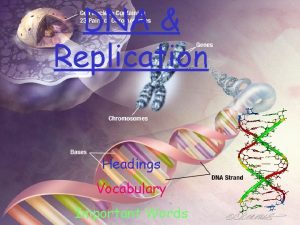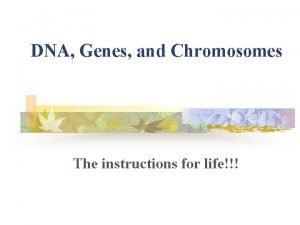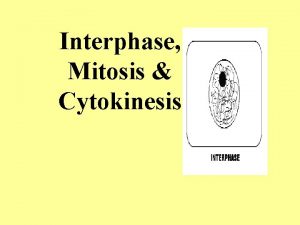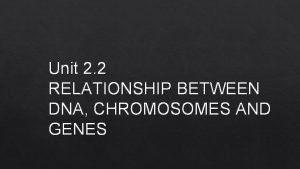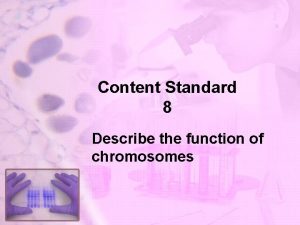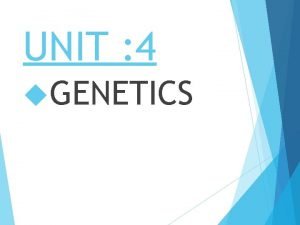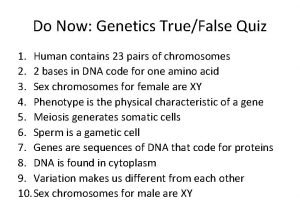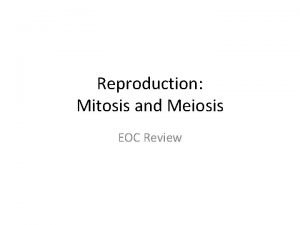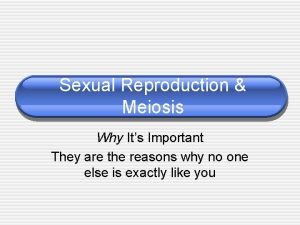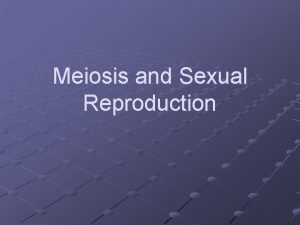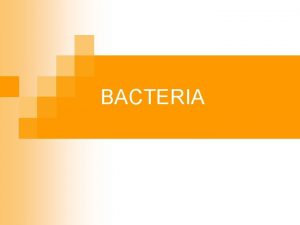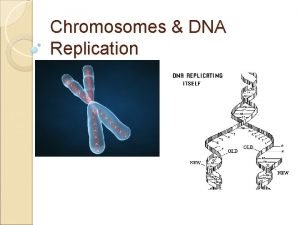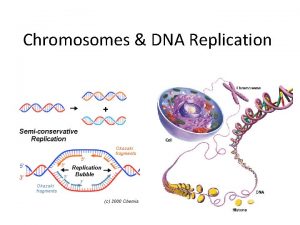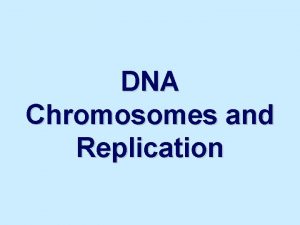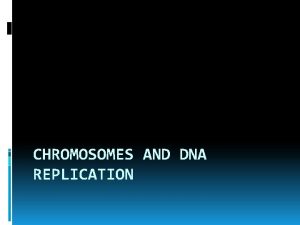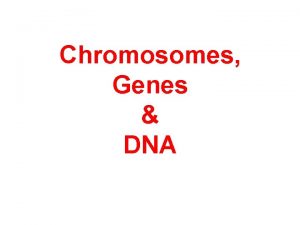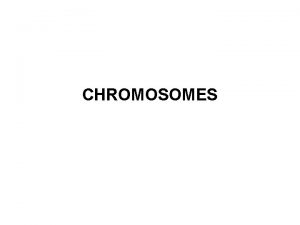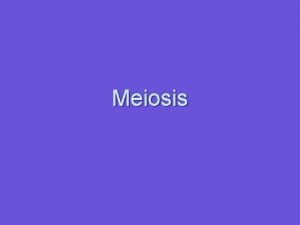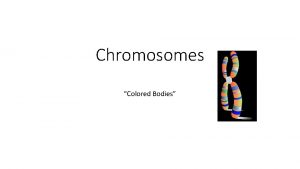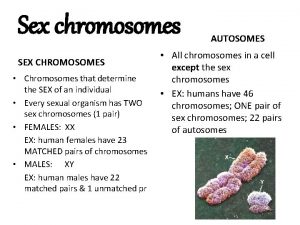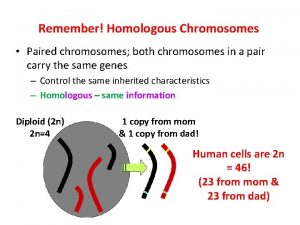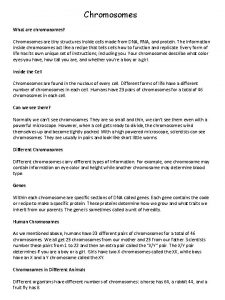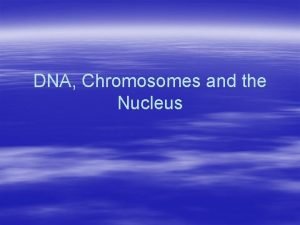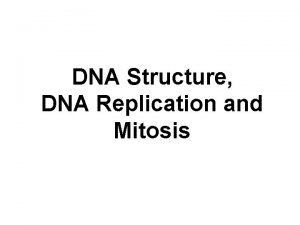Cells DNA and Chromosomes Cells Cells are the

















- Slides: 17

Cells, DNA and Chromosomes

Cells • Cells are the building blocks of all living organisms. • All cells (plant or animal) contain certain common structures. • Each cell has a control centre, the nucleus. • The nucleus contains the genetic material, known as DNA (deoxyribose nucleic acid). • This genetic material is packed in structures called chromosomes.

Cells • On the DNA are the instructions for the growth and development of the entire organism. • This is known as the Genetic code.

Chromosomes • Chromosomes are long thread-like structures found in the nucleus of all cells. • Each member of a species has the same number of chromosomes.

Chromosome Numbers Species Common fruit fly # Species # 8 Guinea Pig 64 Dove 78 Garden snail 54 Earthworm 36 Fern Domestic cat 38 Domestic pig 38 Laboratory mouse 40 Laboratory rat 42 Rabbit 44 Pineapple 50 Hare 46 Human 46 Gorillas, Chimpanzees 48 Domestic sheep 54 Cauliflower 18 Cow 60 Donkey 62 Horse 64 Potato 48 Kingfisher Goldfish 100 -104 Yeast 1200 132 32

Chromosomes • Chromosomes from different species are different in shape and size. • Chromosomes are made up of DNA and proteins called Histones. • Chromosomes come in pairs, of similar shape and size, called homologous pairs. • Humans have 23 homologous pairs of chromosomes.

Chromosomes • The 2 chromosomes of a homologous pair carry genetic information for the same characteristics. • One chromosome of each pair is inherited from the male parent and the other from the female parent. • The part of a chromosome that carries the information for one trait (characteristic) is called a gene.

Chromosomes

Karyotype • Chromosomes can be stained and grouped into their pairs to give a Karyotype.

DNA • All the genetic information a cell needs to grow, function and reproduce is coded within the cell’s DNA. • DNA carried the information for which cells grow, when they grow, when and what chemicals to make, which cells make hair, feathers or fur and the colour and texture. • Even some behaviours are coded for in the DNA e. g. what sort of nest a bird will build.

DNA • DNA is in the shape of a double helix (like a twisted ladder) • Each rung of the “ladder” is made up of two bases – There are 4 different bases : Adenine (A), Thymine (T), Guanine (G), Cytosine (C) – the combination of bases on adjacent rungs make up the genetic code • The sides of the “ladder” are made up of phosphate and sugar (deoxyribose) molecules.

DNA • The order of the bases forms the genetic code. • The bases are complimentary: – A pairs with T – G pairs with C • This is the base pairing rule. AGC TTC GAT CCA CTG TCG AAG CTA GGT GAC

DNA

Proteins • The sequence of bases or genetic code tells the cell what substances to make so that the cell can live, grow and divide. • Three bases code for one amino acid. • Amino acids are the building blocks of proteins. • A gene consists of a sequence of bases that code for a specific amino acid sequence that makes a protein.

Proteins • Therefore, each gene codes for a protein. • Proteins are vital, they: – Form structures like skin, bone and hair – Make up enzymes which control the chemical reactions in cells.

Genes • A gene carries the genetic code for the proteins that determine a particular characteristic. • E. g. the ability to roll your tongue or hair colour. • Each chromosome contains many genes. • The location of a gene on a chromosome is called the locus (plural – loci)

Alleles • Alleles are alternative forms of a gene. • They code for the same characteristic but they have a slightly different order of bases so they cause a different trait. • E. g. brown eyes or blue eyes
 Mikael ferm
Mikael ferm Chromosome vs dna vs gene
Chromosome vs dna vs gene Building vocabulary: the nucleus, dna, and chromosomes
Building vocabulary: the nucleus, dna, and chromosomes Dna, genes and chromosomes relationship
Dna, genes and chromosomes relationship Interphase to cytokinesis
Interphase to cytokinesis What is the relationship between dna chromosomes and genes
What is the relationship between dna chromosomes and genes Chromosomes function in a cell
Chromosomes function in a cell Genes chromosome
Genes chromosome Dna chromosomes genes diagram
Dna chromosomes genes diagram Coding dna and non coding dna
Coding dna and non coding dna Mitosis and meiosis
Mitosis and meiosis How many chromosomes are in a human's sex cells
How many chromosomes are in a human's sex cells Homologous chromosome vs sister chromatid
Homologous chromosome vs sister chromatid Replication
Replication Bioflix activity dna replication nucleotide pairing
Bioflix activity dna replication nucleotide pairing Enzyme involved in dna replication
Enzyme involved in dna replication Chapter 11 dna and genes
Chapter 11 dna and genes Nn
Nn

